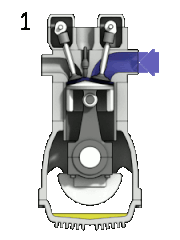Petrol engine

A petrol engine (gasoline engine in American English) is an internal combustion engine designed to run on petrol (gasoline). Petrol engines can often be adapted to also run on fuels such as liquefied petroleum gas and ethanol blends (such as E10 and E85).
Most petrol engines use spark ignition, unlike diesel engines which typically use compression ignition. Another key difference to diesel engines is that petrol engines typically have a lower compression ratio.
Design
Thermodynamic cycle

Most petrol engines use either the four-stroke Otto cycle or the two-stroke cycle.[1][2][3] Petrol engines have also been produced using the Miller cycle and Atkinson cycle.[4][5][6][7]
Layout
Most petrol-powered piston engines are straight engines or V engines. However, flat engines, W engines and other layouts are sometimes used.
Wankel engines are classified by the number of rotors used.
Compression ratio
Cooling
Petrol engines are either air-cooled or water-cooled.
Ignition
Petrol engines use spark ignition and high voltage current for the spark may be provided by a magneto or an ignition coil. In modern car engines the ignition timing is managed by an electronic Engine Control Unit.
Power output and efficiency
The power output of small- and medium-sized petrol engines (along with equivalent engines using other fuels) is usually measured in kilowatts or horsepower.
Typically, petrol engines have a thermodynamic efficiency of about 20% (approximately half that of some diesel engines).[8]
Applications
Applications of petrol engines include automobiles, motorcycles, aircraft, motorboats and small engines (such as lawn mowers, chainsaws and portable generators).
History
The first practical petrol engine was built in 1876 in Germany by Nicolaus August Otto,[9] although there had been earlier attempts by Étienne Lenoir in 1860,[10]: p15 Siegfried Marcus in 1864[10]: p79 and George Brayton in 1876.[10]: pp413–414 [11]
See also
References
- ^ "What is Otto Cycle - Complete Explaintion on P-v & T-s Diagram". The Engineers Post. 10 September 2019. Retrieved 14 August 2022.
- ^ "What is Two Stroke Engine?- Types, And Working". Engineering Choice. 12 November 2020. Retrieved 14 August 2022.
- ^ "Two Stroke Engine - Internal Combustion Engines (IC) - Automobile Magazine". MotorTrend. 16 December 2009. Retrieved 14 August 2022.
- ^ "How does a Miller-cycle engine work?". HowStuffWorks. 1 April 2000. Retrieved 14 August 2022.
- ^ "Mazda 2.3L Miller-cycle DOHC V-6". WardsAuto. 1 January 1998. Retrieved 14 August 2022.
- ^ "Why does Toyota use Atkinson cycle engines?". Toyota UK Magazine. 14 January 2015. Retrieved 14 August 2022.
- ^ "Engines Exposed: Atkinson Cycle Engines". MotorBiscuit. 28 August 2016. Retrieved 14 August 2022.
- ^ "Toyota Gasoline Engine Achieves Thermal Efficiency Of 38 Percent". Green Car Reports. Retrieved 2017-10-07.
- ^ CA 6479 "Gas Motor Engine"
- ^ a b c Friedrich Sass (1962). Geschichte des deutschen Verbrennungsmotorenbaus von 1860 bis 1918. Berlin/Heidelberg: Springer. ISBN 978-3-662-11843-6.
- ^ "Who Invented the Car?".
